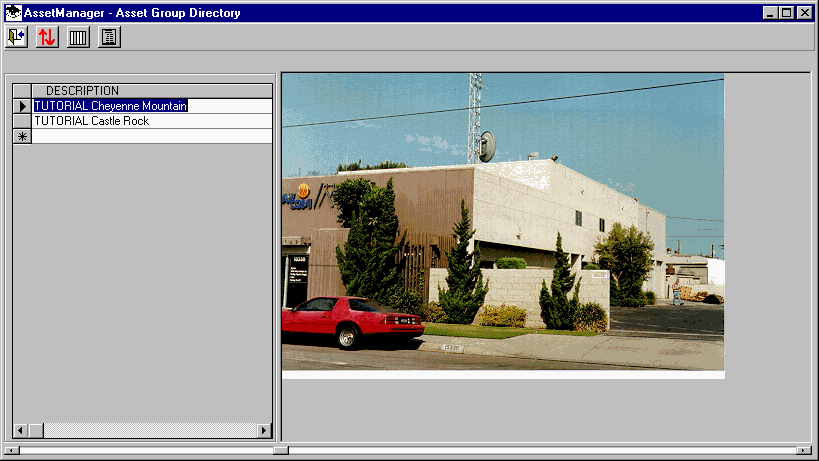
SoftWright's Asset Manager is a database program designed with wireless communication sites in mind. ASSET MANAGER enables you to group together related wireless assets, such as all the equipment at a single repeater site, or at a large antenna farm. You can organize the information to keep track of maintenance schedules, equipment inventory, license expiration dates, driving directions to a site, and a multitude of other pertinent items.
How is ASSET MANAGER organized?
The starting point for ASSET MANAGER data is the ASSET GROUP. When you start the ASSET MANAGER database editor, the list of available ASSET GROUPs is the first form displayed.

The Asset Group Directory form lists the ASSET GROUPs currently contained in the database, and, optionally, an image associated with that ASSET GROUP. Since each ASSET GROUP is typically a particular location (such as an antenna farm, releater site, etc.), you can include a photo of the location or facilities at that site. (Note that all of the sites, facilities, images, equipment, etc., included in this documentation is fictitious and for illustrative purposes only.)
You can define as many ASSET GROUPs as you need. An ASSET GROUP may represent a single base station or repeater, or it may be a large antenna farm with numerous towers and hundreds of licensed facilities. In either case, the ASSET GROUP provides an organizational unit for grouping together all of the information that you want to treat as a unit. Typically, all of the information under a particular ASSET GROUP will be in the same geographic location, but this is not mandatory. If you want separate ASSET GROUPs to represent (for example) each division of your company, and the assets for that division are located around the country, that is possible. The flexibility of ASSET MANAGER enables you to organize the information as it best fits your needs.
When you select an ASSET GROUP by double-clicking a record, the details for that ASSET GROUP are displayed:
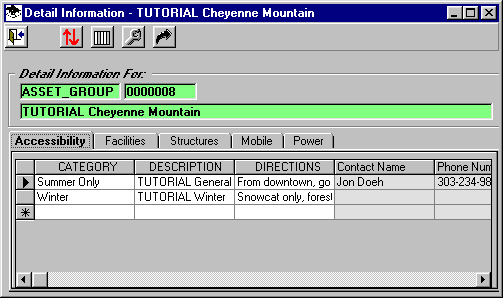
The types of groupings shown on the tabs (such as Accessibility, Facilities, Structures, Mobile, and Power) are described below.
This section summarizes the data associated with the ASSET GROUPs. A later section describes the additional detail information available.
What is an Accessibility record in ASSET MANAGER?
If you select the Accessibility tab on the detail form for an ASSET GROUP, you can enter information about the directions to the location, such as a driving route, lock combinations, phone numbers for a contact person needed to gain access to the site, etc.
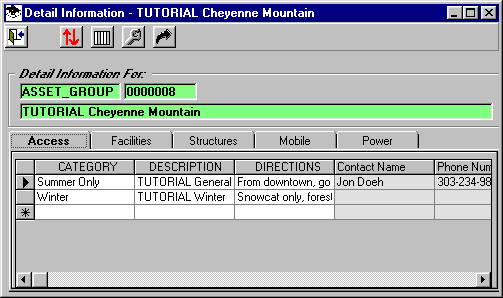
What is a Facility record in ASSET MANAGER?
If you select the Facilities tab on the detail form for an ASSET GROUP, you can enter information about fixed facilities associated with that ASSET GROUP, such as base stations, repeaters, etc.
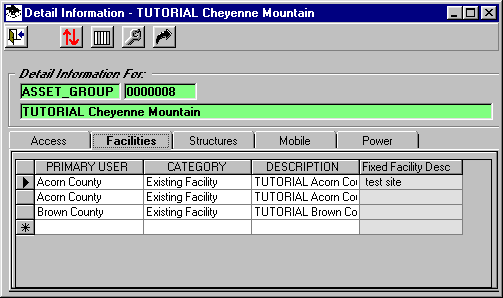
To see more information about a Facility, double-click on the Description for that facility
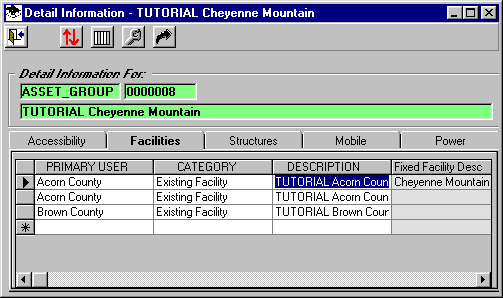
The details for that Facility are displayed:
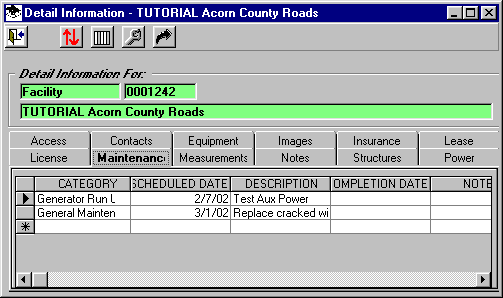
The details for the Facility are represented by several tabs. These tabs are described below.
What is a Structure record in ASSET MANAGER?
If you select the Structure tab on the detail form for an ASSET GROUP, you can enter information about structures located at that ASSET GROUP location, such as towers, poles, buildings, etc.
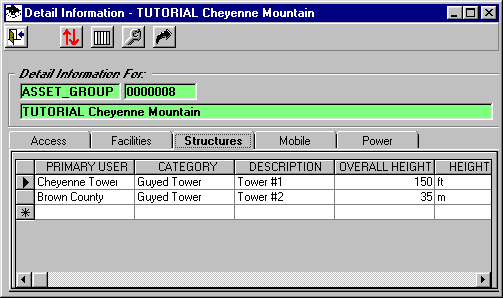
As you will see below, the Facilities associated with the ASSET GROUP can be associated with a particular structure in that ASSET GROUP. This enables you to specify (and generate reports about) which facilities have antennas or other equipment on a particular structure.
What is a Mobile record in ASSET MANAGER?
If you select the Mobile tab on the detail form for an ASSET GROUP, you can enter information about mobile facilities associated with that ASSET GROUP, such as handheld radios, radios in vehicles, pagers, etc.
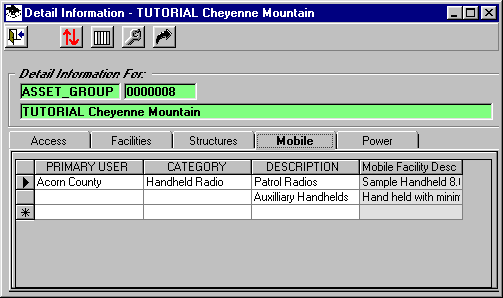
To see more information about a Mobile record, double-click on the Description:
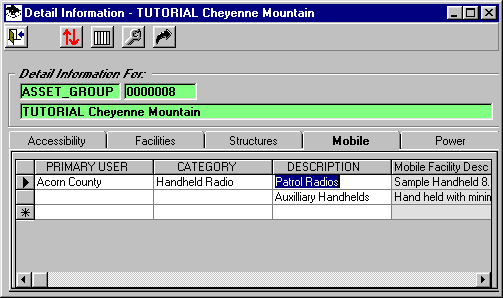
When you double-click on a record for a particular mobile record, the details for that radio are displayed:
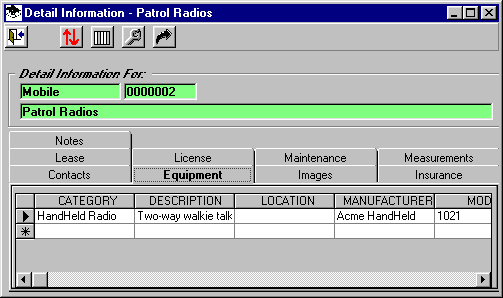
These Detail tabs are described later in this document.
What is a Power record in ASSET MANAGER?
If you select the Power tab on the detail form for an ASSET GROUP, you can enter information about power sources at that ASSET GROUP location, such as commercial power, battery or generator backup, etc.
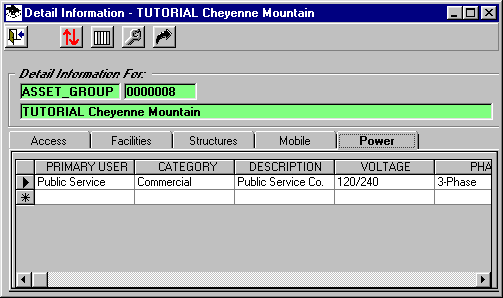
As you will see below, the Facilities associated with the ASSET GROUP can be associated with a particular power source in that ASSET GROUP. This enables you to specify (and generate reports about) which facilities are supplied power by a particular source.
What is an Accessibility record on a Detail form in ASSET MANAGER?
If you select the Accessibility tab on the detail form (for example, for a FACILITY record), you can enter information about the location of that FACILITY, such as a building number, location at a site, etc.
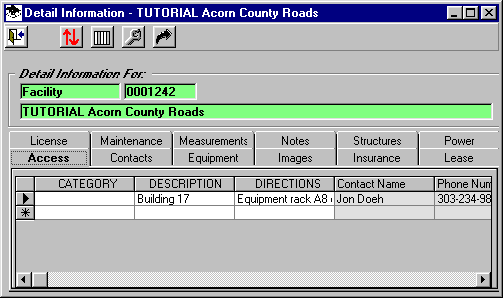
What is a Contacts record in ASSET MANAGER?
If you select the Contacts tab on the detail form (for example, for a FACILITY record), you can enter information about agencies or individuals related to that FACILITY.
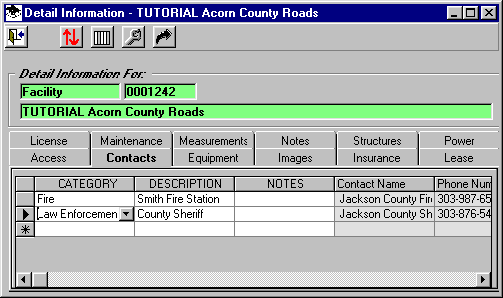
Note that the columns containing the Contact Name and Phone Number information are grayed out, indicating they cannot be edited directly. The Contact information in ASSET MANAGER is stored in the Phone Directory, which you can open by double-clicking on one the Contact Name or Phone Number column.
When you double-click one of these columns, the Phone Directory is displayed:
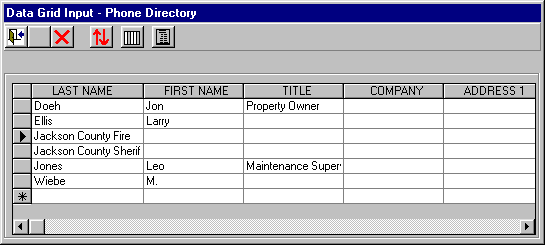
On this form you can create new records with name, phone numbers, FAX numbers, address information, etc.
What is an Equipment record in ASSET MANAGER?
If you select the Equipment tab on the detail form (for example, for a FACILITY record), you can enter information about equipment types, serial numbers, manufacturer, etc.
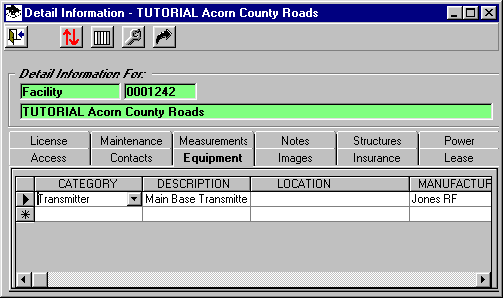
What is an Images record in ASSET MANAGER?
If you select the Images tab on the detail form (for example, for a FACILITY record), you can enter image files (.JPG, .BMP, etc.) related to that FACILITY.
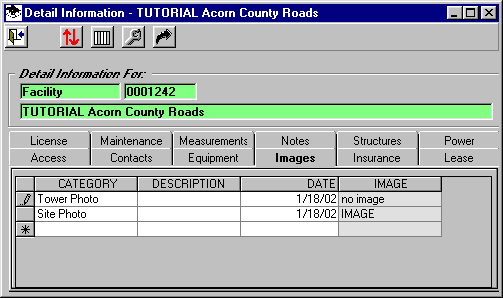
When you double-click the Image column, the Database Image form is displayed:
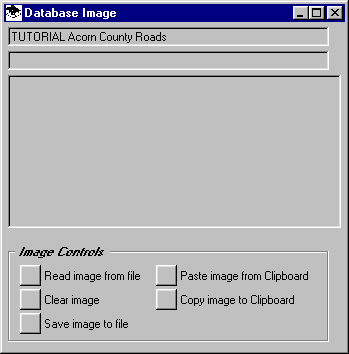
You can use the buttons at the bottom of the form, such as the "Read image from file" to insert an image into the Image database for the FACILITY record:
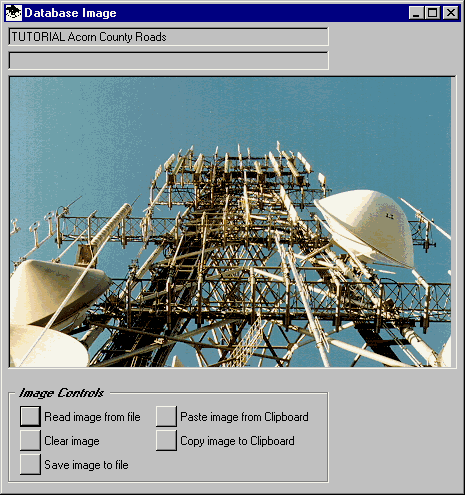
When you return to the Image tab, the "IMAGE" flag in the Image column indicates an image is stored for that record.
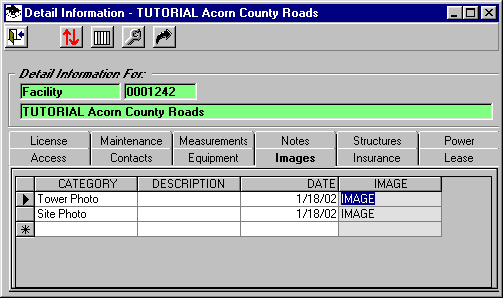
What is an Insurance record in ASSET MANAGER?
If you select the Insurance tab on the detail form (for example, for a FACILITY record), you can enter information about insurance policies, such as policy numbers, renewal dates, etc.
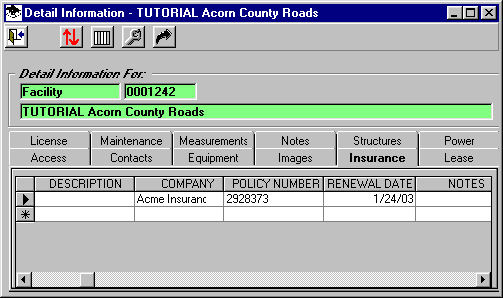
What is a Lease record in ASSET MANAGER?
If you select the Lease tab on the detail form (for example, for a FACILITY record), you can enter information about lease or rental information for the FACILITY.
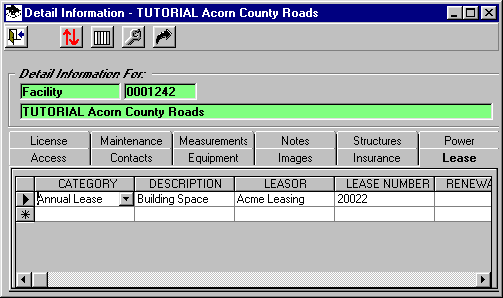
What is a License record in ASSET MANAGER?
If you select the License tab on the detail form (for example, for a FACILITY record), you can enter information about facility license information, renewal dates, etc.
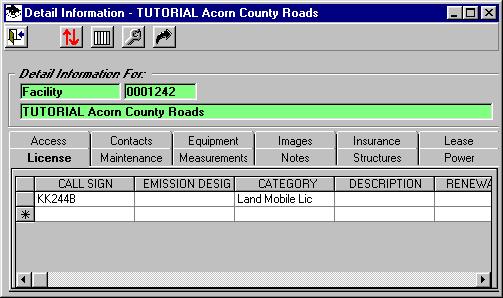
What is a Maintenance record in ASSET MANAGER?
If you select the Maintenance tab on the detail form (for example, for a FACILITY record), you can enter information about scheduled and completed maintenance.
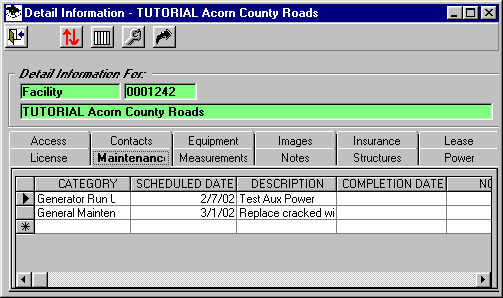
What is a Measurements record in ASSET MANAGER?
If you select the Measurement tab on the detail form (for example, for a FACILITY record), you can enter information about power, field, or other measurements made for a FACILITY.
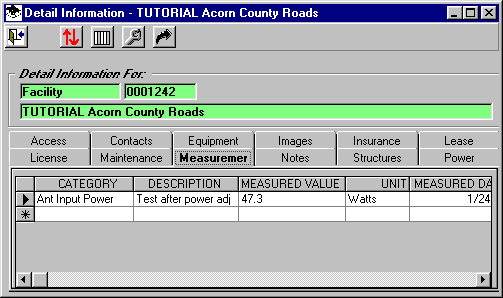
What is a Notes record in ASSET MANAGER?
If you select the Notes tab on the detail form (for example, for a FACILITY record), you can enter extended notes about the FACILITY. Several other tabs include a Notes field for specific data. This Notes tab provides a place to record more general notes for the FACILITY.
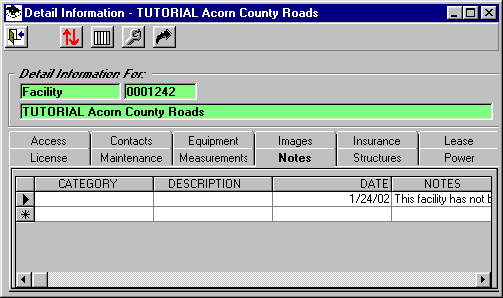
What is a Structures record on the Facility Detail form in ASSET MANAGER?
If you select the Structures tab on the detail form (for example, for a FACILITY record), you can enter information about the location on a structure, such as the bottom and top heights of an antenna on a tower.
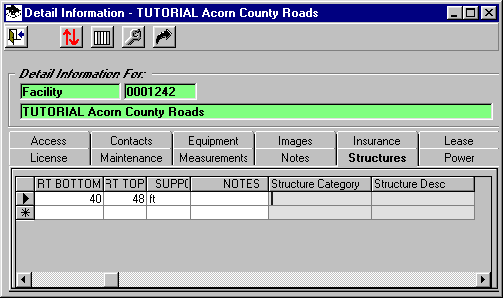
When you double-click the Stucture Category or Structure Desc column, the list of all structures defined for the ASSET GROUP (see above) is displayed, as the "Structure Directory" for that ASSET GROUP:
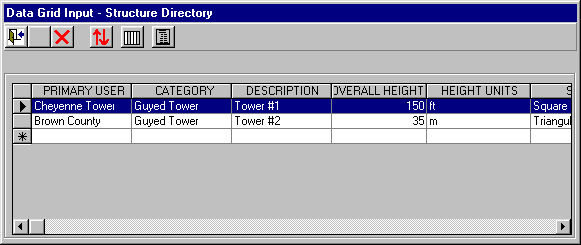
You can select a Structure and exit from the form, and that structure will be added to the Structure record for the FACILITY Detail:
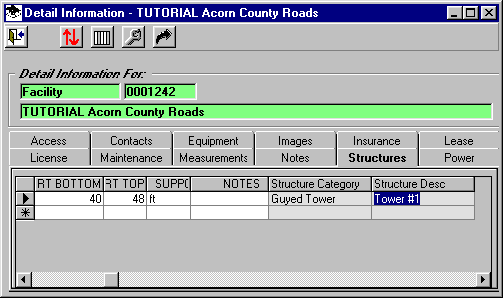
What is a Power record on the Facility Detail form in ASSET MANAGER?
If you select the Power tab on the detail form (for example, for a FACILITY record), you can enter information about the power requirement for the FACILITY.
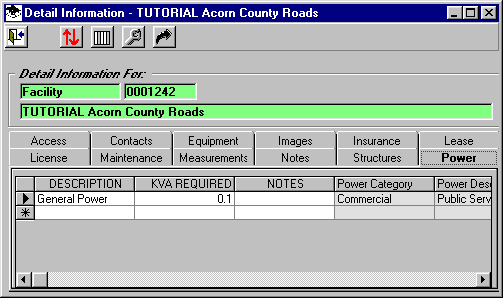
When you double-click the Power Category or Power Desc column, the list of all power sources defined for the ASSET GROUP (see above) is displayed, as the "Power Directory" for that ASSET GROUP:
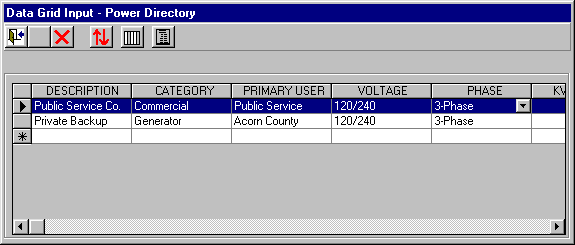
You can select a Power source and exit from the form, and that information will be added to the Power record for the FACILITY Detail:
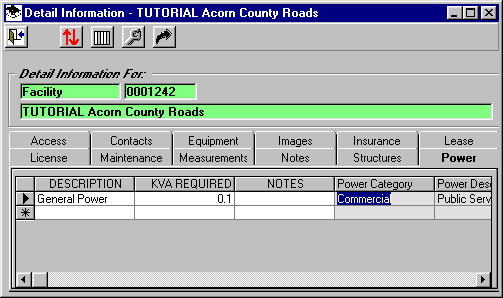
SPECIALIZED FIELDS
What is a "Parent" and an "ID" in ASSET MANAGER?
Parents and IDs are internal values that ASSET MANAGER uses to connect related records in the databases. For example, if a particular ASSET GROUP has a Facility record associated with it, the ASSET GROUP is the "Parent" of that Facility record, identified by the "PARENT TYPE", "PARENT_ID", and "FACILITY ID" values in the records.
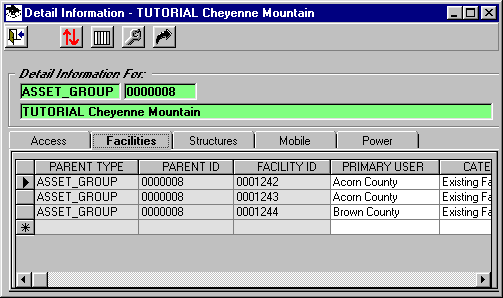
The Parent and ID values are normally in non-visible columns, and are grayed out if they are made visible. You can't (and shouldn't!) edit these fields, and you probably will want to hide them using the Display button on the form (described below).
What is a "category" in ASSET MANAGER data?
A "Category" is a data field that enables you to define the acceptable text that can be entered in that column. In some cases, such as the "Description" for a facility or structure, you will usually have a unique entry for each record. But in other cases, you may want to be able to select from a list of choices (or categories) so that some records can have the same value, avoiding typographical errors, differences in upper and lower case, etc.
For example, in the Category field for Facilities, you might want the choices "Licensed", "Proposed", "Under Construction", or "Abandoned", so you can assign one of these to each facility.
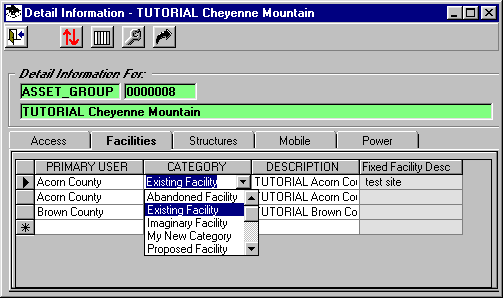
You can create a new category for a particular record type by simply typing in the new text. That text will be automatically added to the list of options for that data. Each database in ASSET MANAGER has its own category list.
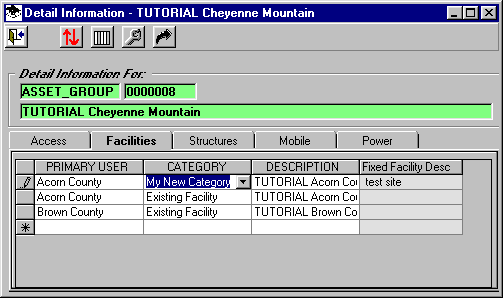
For example, with the Facilities categories listed above, you could also have a different list for Structures, such as "Building Roof", "Guyed Tower", "Self-supporting Tower", and "Pole" in that list for Structure Categories.
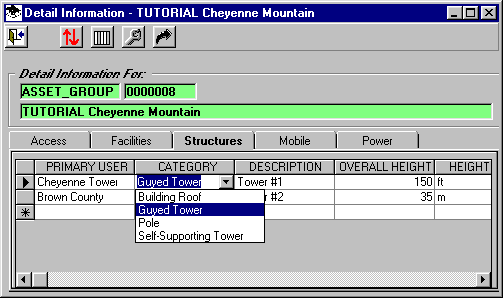
If you need to remove or edit a Category in one of the lists, you can click the Category column, then press the F9 function key on your keyboard:
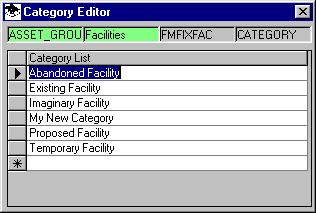
The Category Editor form will be displayed. You can edit any of the categories shown, or you can add a new Category by entering it on the bottom line (shown with the astersik "*" on the left end of the row). If you want to delete one of the Categories, click the selection button on the left end of the row to highlight the item you want to delete. Then press the Delete key on your keyboard to delete the record from the Category list. If you delete a Category from the list, the item will no longer appear in the pulldown list, but the value will remain in any database records where you previously inserted that Category.
What is a "Primary User" in ASSET MANAGER data?
In several of the databases, the "Primary User" field can be used to record an organization that is associated with that record.
The Primary User is a special type of the "Category" data described above. The Category data enables you to build a list of options to select from, and the options are specific to the database they are used in. For example (as shown above), you might want Categories of "Existing Facility" and "Proposed Facility" for Facility records, but different Categories ("Guyed Tower" and "Pole") for Structures.
The Primary User data works like the Categories in the way you add and select the available entries, but the entries are the same for all types of data. For example, suppose you enter a Primary User named "County Sheriff" for a Facility:
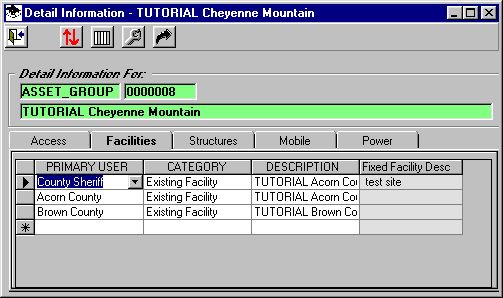
You can select the same entry for a record in the Structures database.
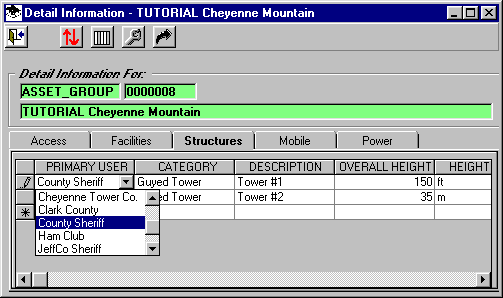
How do I edit information in ASSET MANAGER?
The database information is stored in ASSET MANAGER is presented in a "Browse" mode. In other words, you will see the information in rows and columns. Each column (or "field" in database terms) represents a particular piece of data, such as an equipment serial number, or a scheduled maintenance date. Each row (or "record") represents a specific item, such as two pieces of equipment, with the serial number and maintenance date for each on its own row.
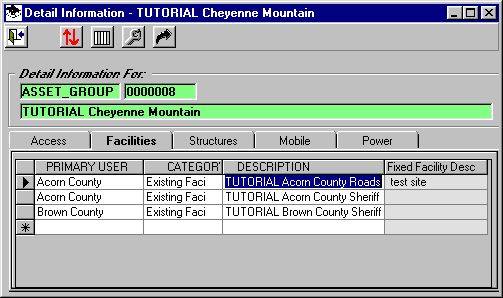
The Browse mode enables you to "edit in place" by simply entering or changing the value shown on the rows and columns.
How do I add new information to ASSET MANAGER?
The Browse mode includes a special row at the bottom of each grid of data (marked with an asterisk "*" to the left of the row).
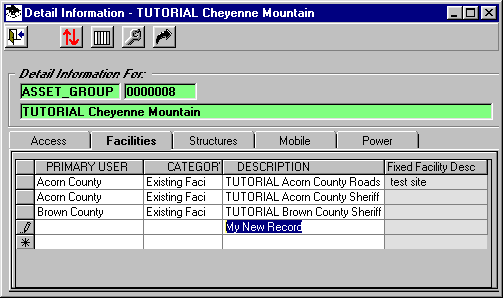
When you start entering data into this row, a new record in is created in the database, shown with a small pencil icon to the left of the row to indicate that the row is being edited. Note that this "*" row is not shown in cases where you cannot add data, such as in a report display.
How do I configure which columns of information I want to see in ASSET MANAGER?
Click the "Display" button on the form:
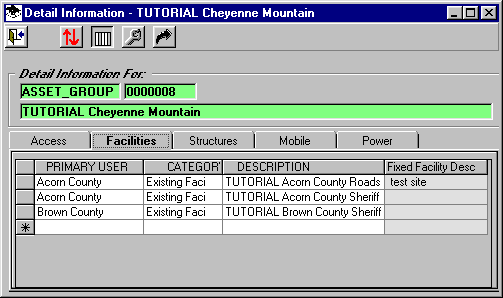
The "Display" button opens a simple form with a checkbox for each column on the current database being edited.
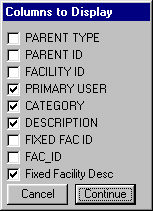
You can mark a check for the columns you want to display, and clear the check for the columns you want to hide.
How do I sort the information in ASSET MANAGER?
When you are editing a database, you can click the top of the column you want to sort on. This will select the column (as shown by the highlighting of the column).
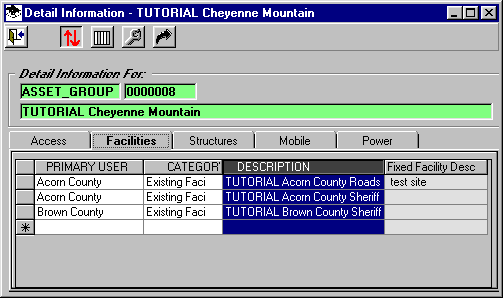
Then you can click the Sort button to sort the data on that column. The direction of the sort will alternate between "ascending" and "descending" order.
How do I find more detailed information for an entry in ASSET MANAGER?
If you double-click on a column, a form will be displayed for any available detailed information related to that record.
For example, when the list of ASSET GROUPs is displayed when you start ASSET MANAGER, only the ASSET GROUP name and (optionally an image) is displayed.

If you double-click on a particular ASSET GROUP, the detail form will be displayed showing the details for that ASSET GROUP.
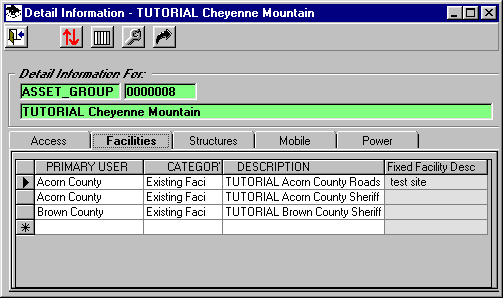
Likewise, if you select one of the Facilities on that list and double-click that Facility, the details for that Facility will be displayed.

Why are some columns gray on the ASSET MANAGER form?
Non-editable columns are shown with a gray background. For example, if a Contact record includes a link to the Phone Directory in ASSET MANAGER, the phone number cannot be edited directly in the Contact record. You can double-click the phone number to open the Phone Directory to edit. When you close the Phone Directory, the new number will be shown in the Contact record. Other non-editable columns that have a gray background (if they are displayed) include internal fields, such as record ID or Parent information.
How do I configure the data editor form in ASSET MANAGER?
You can change the size of the editor form by dragging the sides or corners with your mouse. You can also set the number of tabs displayed by clicking the Configure Tabs button.
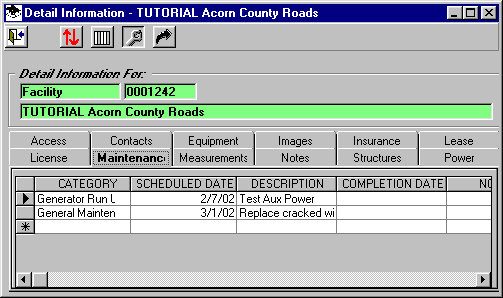
The "Detail Form Configuration" form is displayed:
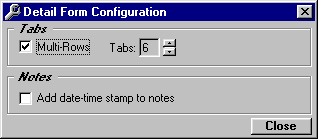
For example, on forms that have a number of tabs, you can allow the tabs to be displayed in multiple rows, and you can specify the number of tabs allows on each row. This enables you to configure the form for your needs to make it readable and convenient for your use.
How do I export data from ASSET MANAGER?
You can select any of three formats to export the data: ASCII with fixed-width columns, ASCII with a user-specified delimiter, or Microsoft Word .DOC file with the columns and rows represented in a Word Table.
To export data, click the "Export Data to File" button on the Detail form:
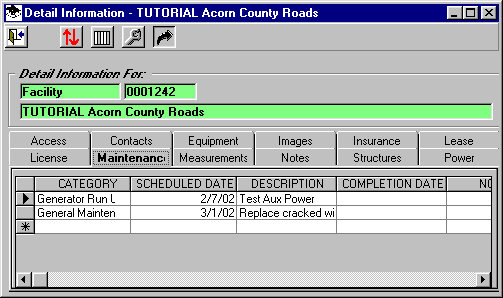
This will display the Export form for the currently displayed tab:

If you select ASCII with a delimiter you can also select the delimiter you want to use (such as a comma or tab character), and whether or not you want each field enclosed in quotation marks.

If any of your descriptions or other fields may contain a comma, you would want to use a different delimiter if appropriate, or include the quotation marks. This is important so that the application you want to use to read the exported file can distinguish between commas in the text and commas as delimiters.
If you select Word DOC output, you can select the fonts to use when the document is created.

When you click the Word Report Fonts button, the Report Fonts form is displayed.
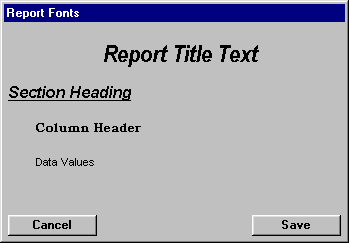
Double-click any item you want to change (such as the Report Title Text) and you will be prompted to select the typeface and font size to use. Once the Word file is completed, you can edit, change fonts, or make other changes just as in any Word document.
The Export function enables you to export the tab that is currently displayed, all the tabs, or tabs you select for the current Parent level.

If you click the "Some Tabs" button, the Tabs to Print form is displayed.
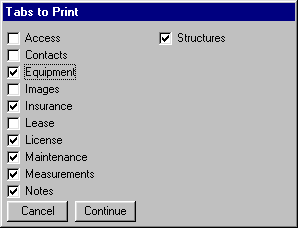
You can mark the check box for each tab you want to export, and clear the box for any tab you do not wish to include.
(More information about ASSET MANAGER Reports.)
|
|
Copyright 2002 by SoftWright LLC